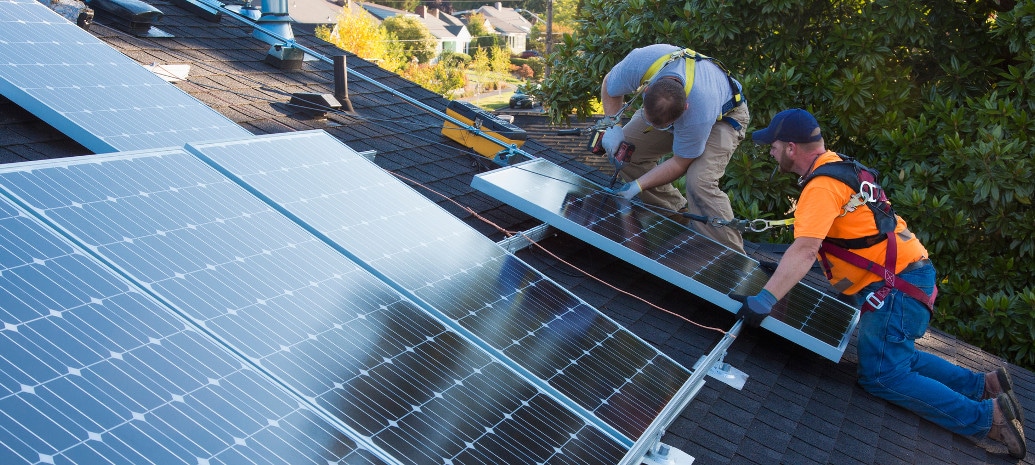By Jean Haggerty
Institutional investor comfort with residential solar asset backed securities (ABS) has entered a new phase, according to industry officials, who point to Solar Mosaic’s recently printed $208 million residential solar loan securitization as the evidence of this shift.
The general trend is towards lower credit enhancement levels for solar ABS, Eric Neglia, managing director at Kroll Bond Rating Agency (KBRA) said. Lower enhancement levels indicate greater comfort with cashflows and asset performance. The credit enhancement level for Solar Mosaic’s Single A rated class was 17.28%.
“(Solar ABS) occupies an attractive space right now… It’s largely investment grade, and a lot of investors are looking for longer term paper with yield,” Kayvan Darouian, director and lead analyst for ABS research at Deutsche Bank said. Mosaic’s recent deal, which KBRA assigned a AA- rating, was oversubscribed, and it priced at 130 basis points, 30 basis points tighter than guidance.
Mosaic is a California-based specialty finance company that originates and services consumer loans used to purchase grid-tied residential solar systems. As an asset class, residential solar ABS includes solar loan securitization transactions, like Mosaic’s, and solar securitizations issued by third-party solar developers, like Sunnova or Sunrun.
Overall, residential solar ABS spreads are in an attractive range, especially considering how low interest rates are currently, said Marc Pangburn, managing director responsible for leading Hannon Armstrong’s private sector investments in solar, wind and land-related products said. Coupons are also at their lowest level ever, he added.
Year-to-date total solar ABS issuance is positioned to match, or marginally exceed, last year’s record $2.1 billion in issuance. This year has already eclipsed 2018 in terms of the number of deals and the number of issuers.
“What’s more important than ABS issuance volume though is investor acceptance along with the number and depth of new investors. The investor profile (for residential solar ABS) has changed while spreads have also contracted,” said Brendan Keane, senior vice president of capital markets at the San Francisco-based Dividend Finance, a renewable energy and energy-efficiency financing company.
The fact that banks are also starting to enter the market as originators is another signal that this ABS asset class – though still relatively esoteric – is becoming more mainstream. In recent months, Dividend Finance has entered into a strategic loan origination partnership with KeyBank and Mosaic has announced a loan origination partnership with SunTrust Bank. “When we are in the market originating, selling or securitizing solar loans, we benefit from the KeyBank association,” Dividend Finance’s Keane said.
Loan securitizations on the rise
Currently, solar loan securitizations are growing at a faster clip than solar lease and solar power purchase agreement (PPA)-backed ABS transactions.
As a product, solar loan securitizations are easier to understand than solar lease and PPA-backed securitizations, and because of this, they are attractive to a broader investor pool, Katrina Niehaus, managing director of corporate securitization at Goldman Sachs said.
Solar lease and PPA-backed ABS deal structures involve additional structuring because in these deals a solar installer can monetize a 30% federal solar investment tax credit (ITC) through tax equity structures, Andrew Coronios, partner at Norton Rose explained.
Currently, the federal ITC for residential solar is set to drop to 26% next year and then fall to 22% in 2021, before disappearing completely in 2022. The U.S. solar industry is eager to see the solar ITC, which was enacted in 2006 and then extended in 2015, renewed for another five years, but several speedbumps – in the form of Congressional gridlock, the administration’s antipathy towards renewable energy, and the soaring federal deficit – exist.
“It is undeniable that (the ITC) was a major factor in raising capital for the solar sector over the past seven years. However, it created certain distortions in how the ABS deals have been structured to accommodate the tax equity investors,” said Ron Borod, principal and founder Ram Island Strategies, a Boston-based firm that provides legal, financial structuring, and strategic advisory services to clients in the non-traditional structured finance markets.
Solar lease and PPA-backed ABS deal structures are expected to become less complex when the ITC for residential solar rolls off. When this happens, deal structures will allow note investors to have a more direct security interest in the solar assets as collateral, rather than having an indirect interest through the developer-sponsor’s cash flow in the tax equity partnerships, Borod added.
“We cannot predict the future economics of these ABS transactions. However, as the ITC rolls off, the ABS structures may become less complex, hopefully leading to additional liquidity in the market,” Pangburn said.
For investors investing in a new assets class it is always a matter of comfort and yields, but the fact that almost all solar securitizations have a green bond opinion attached to them is a bonus. “(The residential solar ABS market) is a clear way to make an investment in renewable energy. The only thing that the proceeds are used for is to install and purchase solar (systems). There is no ambiguity (about) the purpose of the transaction,” Niehaus said.
Typically, solar ABS issuers structure their securitizations in accordance with the International Capital Market Association’s green bond standards.
Next month, the US Structured Finance Association (SFA) is hosting a symposium aimed establishing environmental, social and governance (ESG) metrics and disclosure standards for the securitization industry. The SFA’s ESG initiative will cover the entire securitization market as a whole, not just the solar securitization market. Like the SFA, rating agencies are also looking at how to work ESG analysis and measurements into their ratings methodologies.
This content is protected by copyright and may not be reused. If you want to cooperate with us and would like to reuse some of our content, please contact: editors@pv-magazine.com.









By submitting this form you agree to pv magazine using your data for the purposes of publishing your comment.
Your personal data will only be disclosed or otherwise transmitted to third parties for the purposes of spam filtering or if this is necessary for technical maintenance of the website. Any other transfer to third parties will not take place unless this is justified on the basis of applicable data protection regulations or if pv magazine is legally obliged to do so.
You may revoke this consent at any time with effect for the future, in which case your personal data will be deleted immediately. Otherwise, your data will be deleted if pv magazine has processed your request or the purpose of data storage is fulfilled.
Further information on data privacy can be found in our Data Protection Policy.